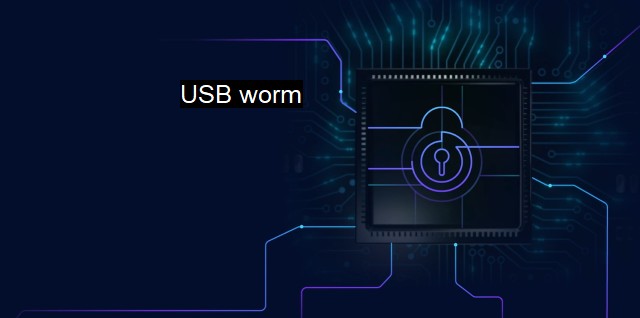What is USB worm?
The Growing Threat of USB Worm: How to Protect Yourself and Your Organization from This Malware Attack
A "USB worm" belongs to a category of malicious software (malware) engineered to propagate through portable drives, most notably USB storage devices. This worm is designed to function automatically, and it will frequently replicate itself across multiple systems, spreading through USB-equipped devices, rendering them vulnerable to potential information theft, data corruption, or unauthorized remote access.In the cybersecurity domain, addressing the risks relating to USB worms is quite critical. Such worms can infiltrate network set-ups—servers, computers, and more importantly, cybersystems of institutions such as corporations, government departments, and financial institutions—leading to severe consequences.
USB worms are so termed as they "travel" to different systems via USB-equipped devices. These sophisticated malicious activities distinguish themselves from conventional computer viruses and similar parasite programs due to their ability to duplicate themselves on various systems without the need for human interaction. Once the infected USB drive is plugged into a computer, the worm activates and gets to work silently, delivering the payload to the peripheral system.
Typically, a USB worm will first make your USB drive its home. It then contaminates the auto-run configuration of the drive. The auto-run configuration is a built-in feature of the USB drive that runs specific files or programs when the device is connected to a computer. The worm piggybacks off this automatic protocol, hence forcing the system to launch the worm's operations as its first task.
The payload, or target, of the USB worm varies on the mimicked worm strain. The worm may corrupt user files, steal delicate information, or transform the infected machine into a 'zombie' to conduct Distributed Denial-of-Service (DDoS) attacks. Often, the worm tries to download other malicious software from the web to bring further disruption or harm. Contrarily, some variations of USB worms might not harm the file system or data but significantly compromise system processes such as slowing down operations, causing frequent crashes, or network interruptions.
Over the last decade, cybersecurity incidents involving USB worms have resulted in threat actors making severe inroads into several networks globally. These strikes have led to several data breaches, causing significant losses and damages running into millions and sometimes billions of dollars. Worms such as Stuxnet, which targets industrial control systems, exemplify the potential of a USB worm to wreak havoc on computer-dependent infrastructure.
Antivirus software plays a crucial role in battling against the perils of USB worms. Updated antivirus software scans and eradicates any traces of malware from USB devices preemptively before they infect the host system. It also helps in multiple scanning scenarios to identify such threats and promptly remove them, mitigating the risk they pose.
Security measures also include updating your operating system and other core programs time and again. Updates generally come with patches which proactively fix loopholes that the malware could exploit. Users need to be aware and discerning regarding their cyber hygiene to reduce the likelihood of being exposed to USB worm attacks.
User checkpoint methods include limiting the use of public or stray USB drives, frequent scanning of devices, ensuring data backups, and employing security lock options that prevent unauthorized entry into systems or software. Prevention methods can often involve simply executing due diligence and not engaging in risky behaviors like visiting unsecured websites or downloading questionable files.
While technology keeps advancing at a rapidly evolving pace, malware such as USB worms continue to present an extensive threat to the realms of cybersecurity. The onus, therefore, falls upon every individual and institution to adopt appropriate cybersecurity measures—to the extent of their knowledge and capability—to safeguard against these imminent threats in an increasingly interconnected world. It's only wise to stay updated on such matters and blend regular learning with cybersecurity best practices into our daily routine. Hence, this will contribute significantly to addressing the mounting challenge that USB worms pose in today's digital age.

USB worm FAQs
What is a USB worm?
A USB worm is a type of malware that infects removable storage devices, such as USB drives. It spreads by copying itself onto an uninfected device when it is connected to an infected device without the user's knowledge.How does a USB worm affect my computer?
When an infected USB drive is inserted into a computer, the worm can spread quickly and infect any other connected devices. It may steal or corrupt files, slow down the computer, or even take control of the system.How can I protect my computer from USB worms?
To protect your computer from USB worms, you should use antivirus software that can detect and remove the malware. Additionally, you should avoid using unknown or untrusted USB drives and always scan them for viruses before accessing them.Can USB worms be removed from infected devices?
Yes, USB worms can be removed from infected devices using antivirus software. It is important to run a full system scan to ensure that all traces of the malware are removed. Additionally, you should disconnect any infected devices and avoid using them until they have been thoroughly cleaned.| | A | | | B | | | C | | | D | | | E | | | F | | | G | | | H | | | I | | | J | | | K | | | L | | | M | |
| | N | | | O | | | P | | | Q | | | R | | | S | | | T | | | U | | | V | | | W | | | X | | | Y | | | Z | |
| | 1 | | | 2 | | | 3 | | | 4 | | | 7 | | | 8 | | |||||||